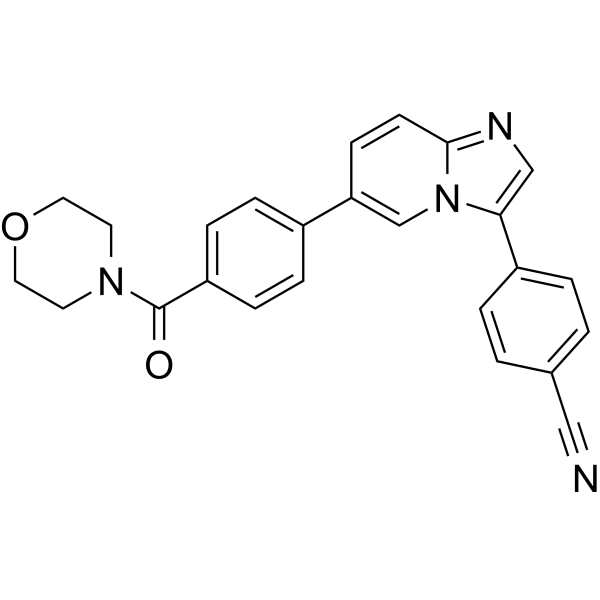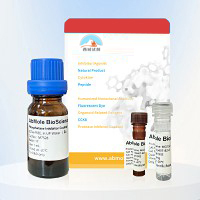Tinodasertib ETC-206,99.57%
产品编号:Bellancom-112424| CAS NO:1464151-33-4| 分子式:C25H20N4O2| 分子量:408.45
本网站销售的所有产品仅用于工业应用或者科学研究等非医疗目的,不可用于人类或动物的临床诊断或者治疗,非药用,非食用,
Tinodasertib ETC-206
| 产品介绍 | Tinodasertib (ETC-206) 是一种选择性 MNK1 和 MNK2 抑制剂,IC50 分别为 64 nM 和 86 nM。 | ||||||||||||||||
|---|---|---|---|---|---|---|---|---|---|---|---|---|---|---|---|---|---|
| 生物活性 | Tinodasertib (ETC-206) is a selective MNK1 and MNK2 inhibitor with IC50s of 64 nM and 86 nM, respectively. | ||||||||||||||||
| 体外研究 |
Tinodasertib (ETC-206) inhibits eIF4E phosphorylation in HeLa cell line with an IC50 of 321 nM. The anti-proliferative effects of ETC-206 are assessed in vitro, using CellTiter-Glo viability assay against 25 hematological cancer cell lines including the K562 cell line that overexpresses eIF4E (K562 o/e eIF4E). The IC50s are 1.71 μM, 3.36 μM, 3.70 μM, 4.81 μM, 5.13 μM, 5.05 μM, 6.70 μM, 9.76 μM, and 48.8 μM for SU-DHL-6, GK-5, MC 116, P3HR-1, DOHH2, MPC-11, Ramos.2G6.4C10, AHH-1, and K562 o/e eIF4E cells, respectively. 西域 has not independently confirmed the accuracy of these methods. They are for reference only. | ||||||||||||||||
| 体内研究 |
The antitumor effect of ETC-206 is then assessed in a K562 e/o eIF4E mouse xenograft model after oral administration at 25, 50, or 100 mg/kg alone or in combination with a 2.5 mg/kg fixed dose of Dasatinib throughout the study. Dasatinib at 2.5 mg/kg elicits a tumor growth inhibition (TGI) of 88% with one tumor-free animal. In contrast, ETC-206 alone only yields a maximum TGI of 23% at the highest administered dose of 100 mg/kg, which does not impede tumor growth, and is similar to the nontreated animals. ETC-206 with 2.5 mg/kg of Dasatinib not only increases tumor growth inhibition in a dose-dependent manner but, more importantly leads to 2, 5, and 8 out of 8 tumor-free animals at 25, 50, and 100 mg/kg, respectively. The combination of ETC-206 and Dasatinib inhibits tumor growth at all tested doses, and no weight loss is recorded. Both the combination of ETC-206 and Dasatinib and, on the other hand, the dual MNK1/2 and BCR-ABL1 inhibitors prevent tumor growth in the same mouse xenograft model. ETC-206 has moderate terminal elimination half-life (t1/2=1.7 h, and 1.77 h for mouse (1 mg/kg, i.v.), mouse (5 mg/kg, p.o.)). 西域 has not independently confirmed the accuracy of these methods. They are for reference only. | ||||||||||||||||
| 体内研究 |
The antitumor effect of ETC-206 is then assessed in a K562 e/o eIF4E mouse xenograft model after oral administration at 25, 50, or 100 mg/kg alone or in combination with a 2.5 mg/kg fixed dose of Dasatinib throughout the study. Dasatinib at 2.5 mg/kg elicits a tumor growth inhibition (TGI) of 88% with one tumor-free animal. In contrast, ETC-206 alone only yields a maximum TGI of 23% at the highest administered dose of 100 mg/kg, which does not impede tumor growth, and is similar to the nontreated animals. ETC-206 with 2.5 mg/kg of Dasatinib not only increases tumor growth inhibition in a dose-dependent manner but, more importantly leads to 2, 5, and 8 out of 8 tumor-free animals at 25, 50, and 100 mg/kg, respectively. The combination of ETC-206 and Dasatinib inhibits tumor growth at all tested doses, and no weight loss is recorded. Both the combination of ETC-206 and Dasatinib and, on the other hand, the dual MNK1/2 and BCR-ABL1 inhibitors prevent tumor growth in the same mouse xenograft model. ETC-206 has moderate terminal elimination half-life (t1/2=1.7 h, and 1.77 h for mouse (1 mg/kg, i.v.), mouse (5 mg/kg, p.o.)). 西域 has not independently confirmed the accuracy of these methods. They are for reference only. | ||||||||||||||||
| 性状 | Solid | ||||||||||||||||
| 溶解性数据 |
In Vitro:
DMSO : ≥ 50 mg/mL (122.41 mM) * "≥" means soluble, but saturation unknown. 配制储备液
*
请根据产品在不同溶剂中的溶解度选择合适的溶剂配制储备液;一旦配成溶液,请分装保存,避免反复冻融造成的产品失效。 In Vivo:
请根据您的实验动物和给药方式选择适当的溶解方案。以下溶解方案都请先按照 In Vitro 方式配制澄清的储备液,再依次添加助溶剂:
——为保证实验结果的可靠性,澄清的储备液可以根据储存条件,适当保存;体内实验的工作液,建议您现用现配,当天使用;
以下溶剂前显示的百
| ||||||||||||||||
| 运输条件 | Room temperature in continental US; may vary elsewhere. | ||||||||||||||||
| 储存方式 |
| ||||||||||||||||
| 参考文献 |








 浙公网安备 33010802013016号
浙公网安备 33010802013016号